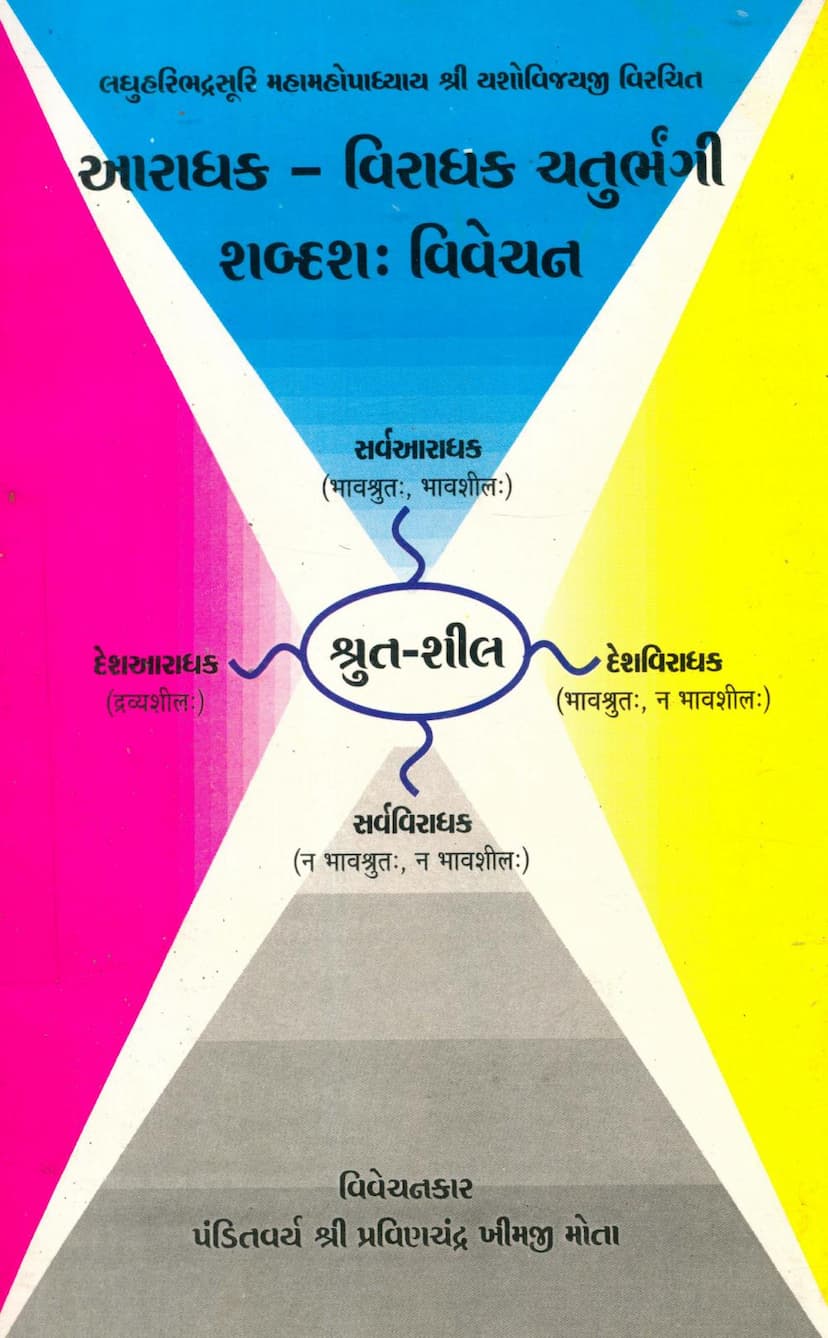Aradhak Viradhak Chaturbhangi Shabdasha Vivechan
Added to library: September 1, 2025

Summary
Here's a comprehensive summary in English of the Jain text "Aradhak Viradhak Chaturbhangi Shabdasha Vivechan" by Pravinchandra K. Mota, based on the provided pages:
Book Title: Aradhak Viradhak Chaturbhangi Shabdasha Vivechan (Analysis of the Four Categories of Worshipper and Non-Worshipper, Word by Word) Author: Pravinchandra K. Mota (Commentator/Analyst) Original Author of the Core Text: Nyayacharya-Nyayavisharad Mahamahopadhyaya Shri Yashovijayji
Publisher: Gitarth Ganga
Overview:
This book is a word-by-word commentary and analysis of the "Aradhak Viradhak Chaturbhangi" (Four Categories of Worshipper and Non-Worshipper), a significant text originally composed by the esteemed Jain philosopher and scholar, Shri Yashovijayji. The original text is a commentary on a classification found in the Bhagavati Sutra (the fifth Anga of the Jain Agamas), which, based on the concept of "Shruta" (scriptural knowledge) and "Sheela" (conduct/virtue), categorizes living beings into four types concerning their spiritual path and adherence to Jain principles.
Core Concept: The Four Categories (Chaturbhangi)
The Bhagavati Sutra, in its eighth Shataka, tenth Uddeśha, outlines four types of souls based on their approach to the path of liberation, considering Shruta (knowledge) and Sheela (conduct/virtue):
- Sarva-aradhak (Total Worshipper): Those who worship both Shruta and Sheela.
- Desh-aradhak (Partial Worshipper): Those who worship either Shruta or Sheela, but not both completely. The text clarifies this as primarily focusing on Sheela (conduct).
- Desh-viradhak (Partial Non-Worshipper/Violator): Those who have Shruta but violate or neglect Sheela.
- Sarva-viradhak (Total Non-Worshipper/Violator): Those who worship neither Shruta nor Sheela.
The original text by Shri Yashovijayji meticulously explains the nature and characteristics of these four categories.
The Commentary by Pravinchandra K. Mota:
Pravinchandra K. Mota's work is a detailed, word-by-word analysis of Shri Yashovijayji's original text. The commentary aims to:
- Clarify Complex Concepts: To make the subtle philosophical points of Shri Yashovijayji's commentary accessible, especially to those who may not be proficient in Sanskrit.
- Elucidate the "Why": To explain the reasoning and purpose behind Shri Yashovijayji's explanations, highlighting the nuances of interpretation based on different philosophical standpoints (Nayas) and the importance of both knowledge (Shruta) and conduct (Sheela).
- Provide Context and Depth: The commentary delves into the scriptural basis for the classification, drawing from the Bhagavati Sutra and other Jain texts. It analyzes the meanings of key terms like "Shruta" and "Sheela," differentiating between "dravya" (gross/material) and "bhava" (subtle/spiritual) aspects of conduct.
- Address Potential Misinterpretations: The commentary tackles possible doubts and counter-arguments (purva-paksha) that might arise from the text, offering resolutions and further clarifications. For instance, it discusses how certain individuals, even those from different philosophical traditions (other darśanas), might be considered "Desh-aradhak" based on their adherence to virtuous conduct (Sheela), provided it aligns with the underlying principles of righteous action.
- Emphasize the Interplay of Knowledge and Conduct: A significant focus is on how the combination and interplay of right knowledge (Shruta) and right conduct (Sheela) determine one's spiritual progress. The commentary explains that merely having knowledge without conduct, or conduct without knowledge, leads to partial worship or non-worship. True liberation (Moksha) requires the integration of both.
- Highlight the Goal of Self-Reflection: The ultimate aim of understanding this classification is to enable the reader to self-introspect and determine their own spiritual standing, motivating them to strive for higher levels of adherence and, ultimately, liberation.
Key Points from the Commentary:
- "Sheela" as Primary for Partial Worshippers: The commentary emphasizes that in the context of "Desh-aradhak," the primary focus is on the adherence to "Sheela" (conduct or virtue), which is seen as the immediate cause of liberation.
- Distinction Between "Dravya" and "Bhava" Sheela: The commentary differentiates between gross (dravya) and subtle (bhava) forms of conduct. "Dravya Sheela" refers to external observances, while "Bhava Sheela" refers to internal purity and adherence guided by right knowledge.
- The Role of "Shruta": Right knowledge (Shruta) is crucial for guiding conduct and ensuring it leads towards liberation. The commentary explains how even virtuous actions performed without right knowledge can be considered "Desh-viradhak" if they deviate from or neglect the true essence of the path.
- Reconciling Different Views: The commentary addresses the potential for differing interpretations, particularly concerning individuals from other philosophical traditions or those who practice austerities (like "Bal Tapasvi" or "Agyatarthi"). It explains how, from a broader perspective or based on specific Nayas, certain virtuous actions can be seen as contributing to spiritual progress, even if not fully aligned with the deepest understanding of Jain philosophy.
- The Importance of Right Attitude: The commentary underscores that mere external adherence (Dravya) is insufficient without the right internal disposition and knowledge (Bhava). The correct understanding of scriptural knowledge (Shruta) is essential to guide and purify conduct (Sheela).
- The "Chaturbhangi" as a Framework for Self-Assessment: The text serves as a tool for self-assessment, enabling individuals to understand their current spiritual state and identify areas for improvement to ascend towards "Sarva-aradhak" status.
- Clarification of "Anaradhak" and "Viradhak": The commentary clarifies that those who have not undertaken vows are also considered "anaradhak" (non-worshippers) of those specific vows. However, the "Chaturbhangi" primarily focuses on classifying those who are on a path, by either worshipping or violating the core principles of Shruta and Sheela, often subsuming "anaradhak" within the broader category of "viradhak" when considering the absence of adherence.
Significance:
This book is valuable for Jain scholars, practitioners, and anyone interested in understanding the profound ethical and philosophical classifications within Jainism. It bridges the gap between complex ancient texts and modern understanding, offering a detailed exploration of spiritual progress and the interconnectedness of knowledge and conduct in achieving liberation. The detailed word-by-word commentary ensures that the original wisdom of Shri Yashovijayji is presented with clarity and accuracy.